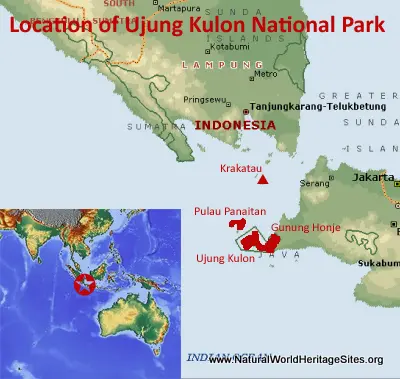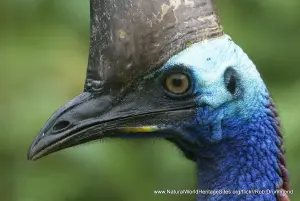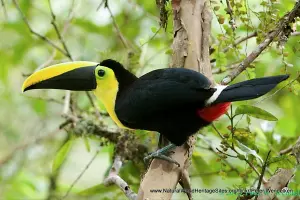EXPLORE the Ujung Kulon National Park with this slideshow, check the location map and get all the facts and information below.
For slideshow description see right or scroll down (mobile). Click to view slideshow
Location and Values: Ujung Kulon National Park is located in the far south-west of the heavily-populated Indonesian island of Java where it protects the largest remaining area of lowland tropical rainforest on the island. It includes four distinct components, namely (1) the triangular peninsula of Ujung Kulon (‘West point’), (2) an adjacent area of the forested Gunung Honje massif, (3) a group of raised coral islands and their fringing reefs lying to the north of the peninsula and (4) an archipelago of four islands around the highly active volcano of Krakatau.
The site is outstanding as a final refuge for rare and endangered plants and animals, including the last viable population of Javan rhinos in the wild (thought to number about 60 individuals). The Krakatau islands are of great scientific interest because they provide one of the world’s best examples of recent island volcanism and tropical vegetation succession. The central island in the group, Anak Krakatau (‘child of Krakatau’) emerged as a new island in 1930 (with significant later eruptions in 1952, 1972, 1992 and 1994) and supports vegetation in the early stages of succession.
Conservation Status and Prospects. According to IUCN’s Conservation Outlook Assessment (2020) the conservation status of Ujung Kulon National Park is ‘good, with some concerns’. The IUCN report notes that the management authorities have succeeded in halting rhino poaching for the past two decades and the park’s world heritage values are being maintained. However, it also identifies a number of significant conservation threats including (1) the rapid spread and over-abundance of the palm, Arenga obtusifolia, which seems to be reducing the suitability of natural habitats for rhinos and displacing other rare species; (2) poaching of birds and other animals for the wildlife trade; (3) illegal fishing and use of destructive fishing methods in the park’s marine zone; (4) potential risks of disease transmission to rhinos from domestic water buffaloes; and (5) the potential for a major eruption of Anak Krakatau which could result in a tsunami and the destruction of critical habitat for rhinos and other critically endangered species. These risks underline the importance of establishing a secure second population of Javan rhinos in the wild at another location.
Links:
Google Earth
Official UNESCO Site Details
IUCN Conservation Outlook
UNEP-WCMC Site Description
Birdlife IBA
Slideshow description
The slideshow ‘tells the story’ of Ujung Kulon National Park with a portfolio of photos that illustrate its landscape features and some of the typical plants and animals. It starts with views of the picturesque coastline and islands on the northern side of the Ujung Kulon peninsula, and some images of the forest interior accessed through the palm-fringed waterways by boat. Photos of some of the typical plants and animals in this part of the park include (in order of appearance): the park’s three endemic primates (Javan Surili leaf monkey, Java Gibbon and Ebony leaf monkey), colugo, Javan Rusa deer, long-tailed macaque, fruit bats, banteng, wild boar and some rare pictures of Javan rhino in the wild.
The second part of the slideshow is focused on Krakatau, starting with distant views of the archipelago from the southern shores of Sumatra and some spectacular (night and day-time) photos of volcanic eruptions on the island. It then takes a closer look at the lava flows, sulfurous vents and vegetation on Anak Krakatau.
The following Flickr photographers and other sources are acknowledged with thanks for their contributions to this slideshow (as credited in the watermark of each photo): Wade Strickland, Alex Steele, dotie5647, Egloute, Michael Heiniger, Richard Arculus, RJR Krakatau Tour, Simamat, Siushi, Tamanduta, Tom Pfeiffer, AFW Photography, Alex Newman, asiapulppaper, ChAris Backpacking Journey, felladzy, jambrohero, Julien, Nugroho Adi and Rekha Pratita. Note that some of the close-up photos of animals are from other locations (including animals in captivity), and these are included for illustrative purposes, as representatives of the species found in Ujung Kulon National Park.
Factfile
Website Category:
Tropical & Sub-tropical Forests;
Area: 785 km2
Inscribed: 1991
UNESCO Criteria:
- Exceptional natural phenomenon (vii);
- Outstanding natural beauty (vii);
- Natural habitat for biodiversity (x);
- Significant number of rare, endemic and/or endangered species (x)





